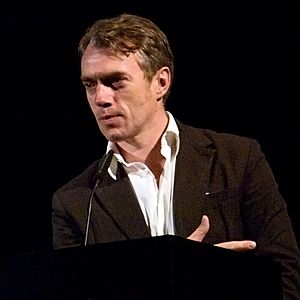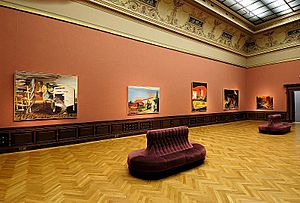Neo Rauch facts for kids
Quick facts for kids
Neo Rauch
|
|
|---|---|

Rauch in Brühl, Germany, 2007
|
|
| Born | 18 April 1960 Leipzig, East Germany (now Germany)
|
| Nationality | German |
| Education | Hochschule für Grafik und Buchkunst Leipzig |
| Known for | Painting |
| Movement | New Leipzig School |
| Awards | Vincent Award, 2002 |
Neo Rauch (born 18 April 1960) is a famous German artist. He is known for his unique paintings. His art often mixes his own life experiences with ideas about factories and work. His style shows influences from socialist realism, which was an art style from communist countries. He also gets ideas from Surrealists like Giorgio de Chirico and René Magritte.
Neo Rauch studied art at the Hochschule für Grafik und Buchkunst Leipzig in Germany. He lives near Leipzig and is a main artist of the New Leipzig School. This is a group of artists from Leipzig who became well-known after 1990.
His paintings often look like they tell a story. But when you look closely, they can be a bit mysterious. For example, buildings might not make sense, and people from different times might appear together. Big events seem to happen, but it's not always clear why.
Contents
Life of Neo Rauch
Neo Rauch had a very difficult start to life. His parents died in a train accident when he was only four weeks old. His father, Hanno Rauch, was 21, and his mother, Helga Wand, was 19. Both were art students at the Hochschule für Grafik und Buchkunst Leipzig.
Neo Rauch was raised by his grandparents in a town called Aschersleben. He finished high school there. Later, he followed in his parents' footsteps. He studied painting at the Hochschule für Grafik und Buchkunst Leipzig from 1981 to 1986. He continued his studies with Professor Arno Rink and Professor Bernhard Heisig.
After East Germany changed in 1990, Rauch worked as an assistant at the Leipzig art academy. From 2005 to 2009, he was a professor there himself. He also helped organize art shows.
Neo Rauch works with his wife, who is also an artist named Rosa Loy. Their studio is in an old cotton factory in Leipzig. He says this place helps him focus and get new ideas. In 2016, a film about him was made, called Neo Rauch: Comrades and Companions.
Art Exhibitions
Neo Rauch had his first solo art show in 1991 in Leipzig. In 1993, his art was shown in Frankfurt. He won the Vincent Award in 2002, which led to a special show of his art in the Netherlands.
In 2010, two major museums in Germany, the Museum der bildenden Künste in Leipzig and the Pinakothek der Moderne in Munich, held a big show of his past works. Some of these works then traveled to Poland in 2011. In 2007, a show called "Neue Rollen" displayed 13 years of his art in Prague.
His art has been shown in many other places around the world. These include the Musée d’art contemporain de Montréal in Canada (2006). His work was also seen at the Kunstmuseum Wolfsburg in Germany (2006). Other places include the Centro de Arte Contemporáneo Málaga in Spain (2005) and the Albertina in Austria (2004).
In 2005, his art was part of the Carnegie International in Pittsburgh, USA. He had his first solo museum show in North America at the Saint Louis Art Museum in 2003-2004. In 2013, he had his first solo show in Belgium. It was at the Centre for Fine Arts in Brussels and was called Neo Rauch. The Obsession of the Demiurge. Selected Works 1993-2012.
Neo Rauch's Works
Neo Rauch believes that painting is a very natural way to understand the world. He sees it as a flow of ideas that come to him. He feels like he is a filter for ideas that come from time itself.
Rauch is part of the New Leipzig School art movement. His paintings often use a style similar to Social Realism. This was an art style that showed everyday life, often in a very realistic way. Some people see his art as a modern kind of Surrealism, especially in America.
Neo Rauch is often called an "East-West painter." This is because his art combines ideas from both the old communist East and the Western world. His paintings often show people in scenes where American comic book styles meet the realistic art of communism.
In 2007, Neo Rauch created a special series of paintings for an exhibition at the Metropolitan Museum in New York City. This show was called "Para." Rauch liked the word "para" because it can mean many things. He said his works for "Para" didn't have one specific meaning. They could mean different things to different people.
He explained that when he agreed to the Met exhibition, he first thought about making art about museums. But he realized he was more interested in the "visions" that came to him in his studio. He calls them "visions" because they are like internal pictures that appear in his mind. He feels he has to accept whatever he discovers this way.
Paintings for "Para"
Some of the paintings created for the "Para" exhibition include:
- Jagdzimmer (Hunter's room), 2007
- Vater (Father), 2007
- Die Fuge (The Fugue/The Gap), 2007
- Warten auf die Barbaren (Waiting for the Barbarians), 2007
- Para, 2007
- Paranoia, 2007
- Goldgrube (Gold Mine), 2007
- Vorort (Suburb), 2007
- Der nächste Zug (The Next Move/The Next Draw), 2007
- Die Flamme (The Flame), 2007
The "Para" paintings often show three main ideas. These are: a sense of community from before communism, the art style of communist Social Realism, and beautiful, dream-like countryside scenes. The word "para" itself can make you think of words like para-normal or para-noia. For example, the painting Paranoia might show ideas about how we understand things in a closed-off space.
Leipzig, where Rauch was born, has a history as a city of trade. This spirit of a trading city was also present during communism. Leipzig was a center of resistance that helped lead to big changes in East Germany. Rauch uses characters and images from the lives of people before communism. These people's lives were controlled by the communist government in East Germany. The way communism controlled people's lives is one of the ideas in Rauch's art.
Awards and Recognition
Neo Rauch has received several important awards for his art:
- 1992 Renta-Preis, Nuremberg
- 1997 Kunstpreis der Leipziger Volkszeitung, Leipzig
- 2002 Vincent Award, Bonnefanten Museum Maastricht, Netherlands
- 2005 Kunstpreis Finkenwerder
- 2010 Stiftungspreis der ökumenischen Stiftung Bibel und Kultur 2010, Stuttgart
- 2012 Order of Merit of Saxony-Anhalt
- 2018 Order of Merit of the Federal Republic of Germany - Grand Cross 1st Class
Where to See His Art
You can find Neo Rauch's paintings in many public art collections around the world. Some of these include:
- Bonnefantenmuseum, Maastricht
- The Broad, Los Angeles
- Carnegie Museum of Art, Pittsburgh
- Hamburger Bahnhof - Museum für Gegenwart, Berlin
- Hamburger Kunsthalle, Hamburg
- Kunstmuseum Den Haag, The Hague
- Kunstmuseum Wolfsburg
- Museum de Fundatie, Zwolle
- Museum der bildenden Künste, Leipzig
- Museum of Contemporary Art, Los Angeles
- Museum of Modern Art, New York
- National Gallery of Canada, Ottawa
- Pinakothek der Moderne, Munich
- San Francisco Museum of Modern Art
- Stedelijk Museum Amsterdam
See also
 In Spanish: Neo Rauch para niños
In Spanish: Neo Rauch para niños



